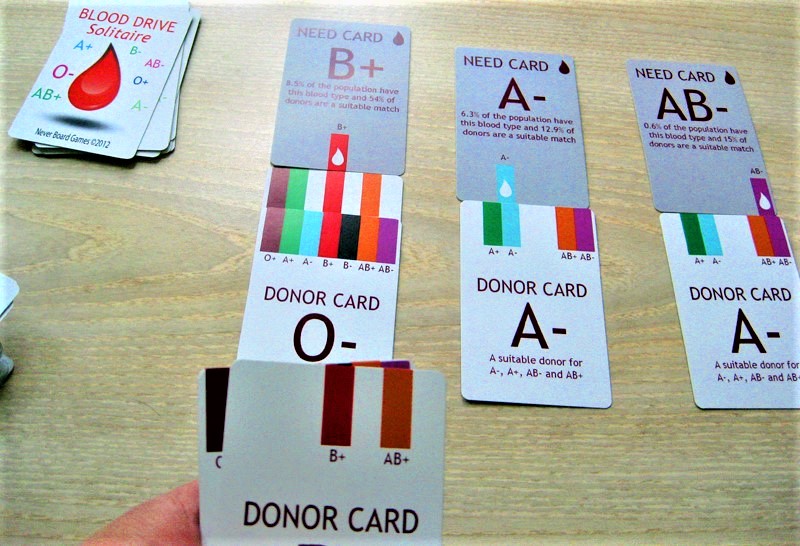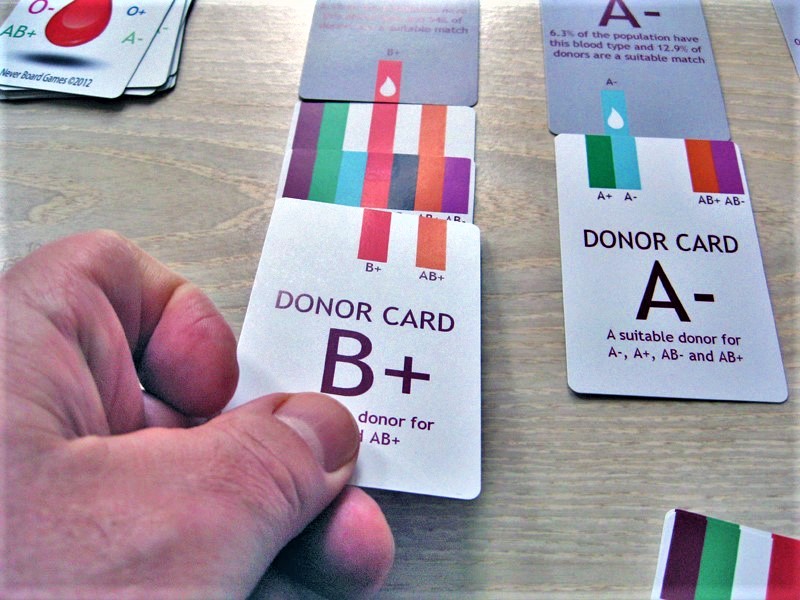Roughly ten years ago I was diagnosed with a blood clotting disorder called ITP. I consider myself lucky however, as my platelets usually hover around 60,000-90,000 which generally doesn’t require hospitalization or treatment if you’re careful. There are folks out there who have much lower levels and require weekly IVIG treatments and steroids to stay out of the red zone. It’s serious medical issues like this that folks need to be aware of as it can happen to anyone and that’s why I was happy to check out “Blood Drive Solitaire“, a card game that promotes blood donation. Before we begin I’m required by FCC regulations to disclose that I was paid to cover this game, though any and all opinions are my own.
To set up the game, you’ll separate the Need and Donor cards and shuffle them into their own face-down stacks. 3 Need cards will be dealt face-up, to be replaced by the deck of Need cards as these are fulfilled. 3 Donor cards are dealt face-down at first in a stack, then taken/viewed so that only the bottom card is visible. It’s kind of like regular “Solitaire’s” draw three variant but here, you can’t see the cards behind the third card.

To play, you’ll look at the Donor card in your hand and attempt to match it with a Need card by playing the former under the latter. If you did, you should still have two cards in your hand with only the second one being visible. You’ll continue to play Donor cards under matching Need cards until you can’t match or run out of cards in your hand. If you can’t make a match, discard all the cards in your hand and draw three more. When a Need card gets three Donor cards assigned to it, you’ll discard the donors and place the Need card into your score pile. You’ll then replace it with a card from the Need deck, if possible.
Play continues until no more Donor cards can be drawn and the last of your cards have been played. I’m fairly certain that there’s a typo in the rules sheet I was given, telling me that the points I earned is equal to my “completed Donor cards”. This should be “Need cards”, in my opinion, as you’re discarding Donor cards whether they contributed to a Need or couldn’t play them to the same pile. It’s common sense, but worth mentioning for casual players who aren’t familiar with the idea of “score piles”. There’s no chart telling you how well you did, so I suppose you can keep track another way and simply try to beat your high score in the future.

“Blood Drive Solitaire” is an extremely light game, one that can be played in as little as 15-20 minutes. As the name implies it’s appropriate for one player, though I would encourage parents to play with their kids in a cooperative fashion should they take the dive. This game is designed to be educational while giving you something to do at the same time and for those of you who know me, I’m all for games that have this design style. “Blood Drive Solitaire” could easily be adapted to a classroom setting, again either as a solo game or more of a teaching aid coupled as an activity.
At present, “Blood Drive Solitaire” is being sold on The Game Crafter for $12.99. From what Game Developer Paul Hock tells me, he’s “working on a way to fund and donate the game as a promo item given out by Blood Banks.” He continues by explaining that his wish is to get the production quality up to suitable levels. As such, I should stress that what I received (and what you could receive if purchasing the game through the aforementioned page) is a prototype. Prototypes aren’t generally reflective of the final product, so I’m opting to preview this game rather than review it. While the developer didn’t mention it, I think it would be great to give some sort of discount to buyers of the prototype who wish to purchase a better version down the line. I suppose it’ll depend on how much more content there is in the future versions and etc.
As mentioned above this is a preview and I don’t generally review prototypes, but I do want to praise the developer for adding facts and tidbits of information on the cards themselves. The Donor cards tell you what that blood type is compatible with, while Need cards give you a sentence or two of a fact with which you probably weren’t aware. The little lines on the cards help make matching extremely easy. While not mentioned on the rules sheet, you can make the experience easier by letting players (or yourself) see the cards under the top Donor card in your hand, just so you can plan ahead and maximize your card plays.
I love seeing games with an educational twist and this one is no exception. If it weren’t for my own medical issues/bills, I’d be backing games like this financially more often.
—
Buy: https://www.thegamecrafter.com/games/blood-drive-solitaire
—

Thanks for the thorough explanation. I love your clarity when introducing games.
I have updated the art to correct for the typo that you mentioned. All GameCrafter purchases will have the corrected rules. -Paul Hock, designer
The GameCrafter art work has been updated to correct the typo. Thanks for the clear and concise presentation of the game rules. -Paul Hock, designer
Thanks for the update!